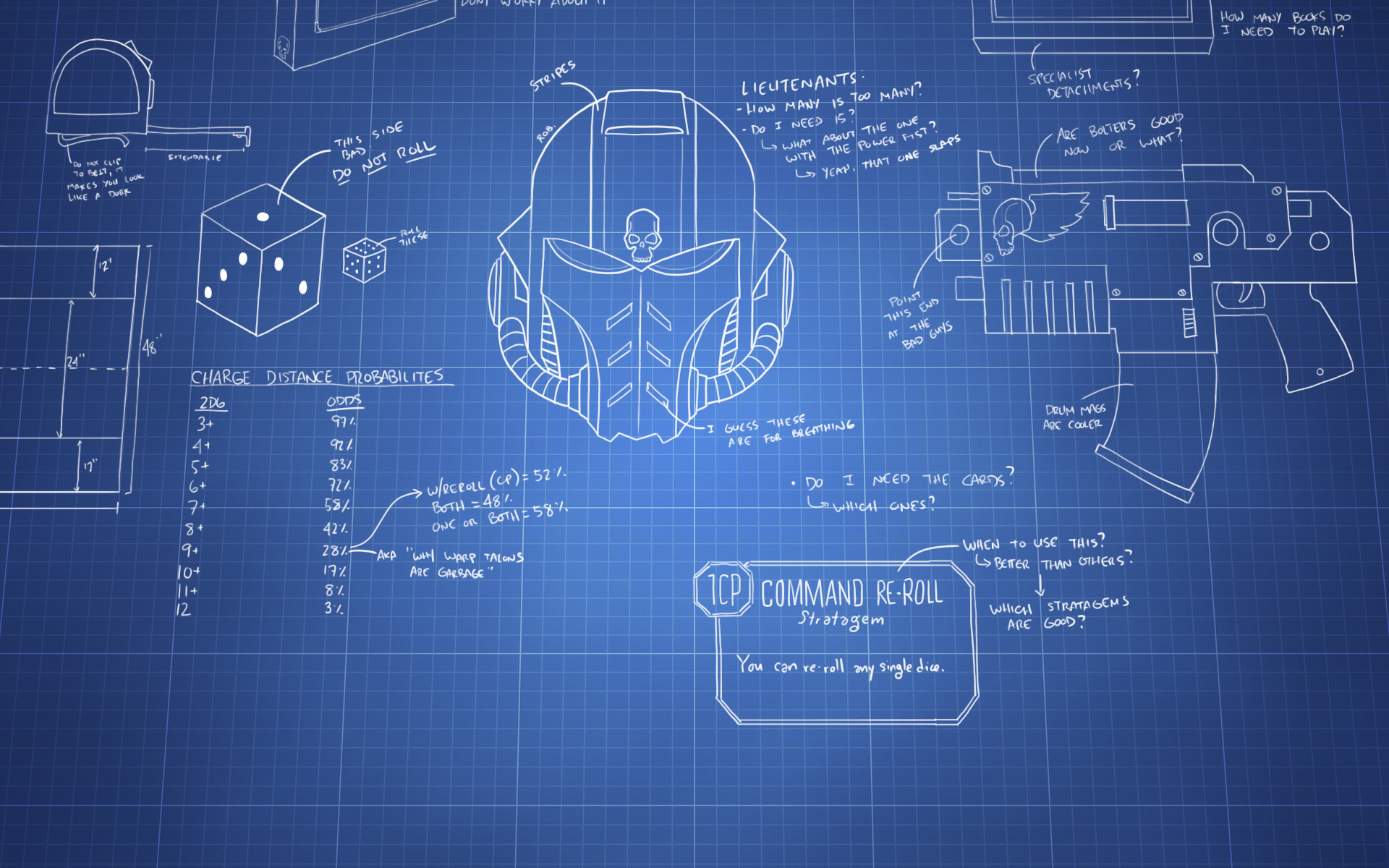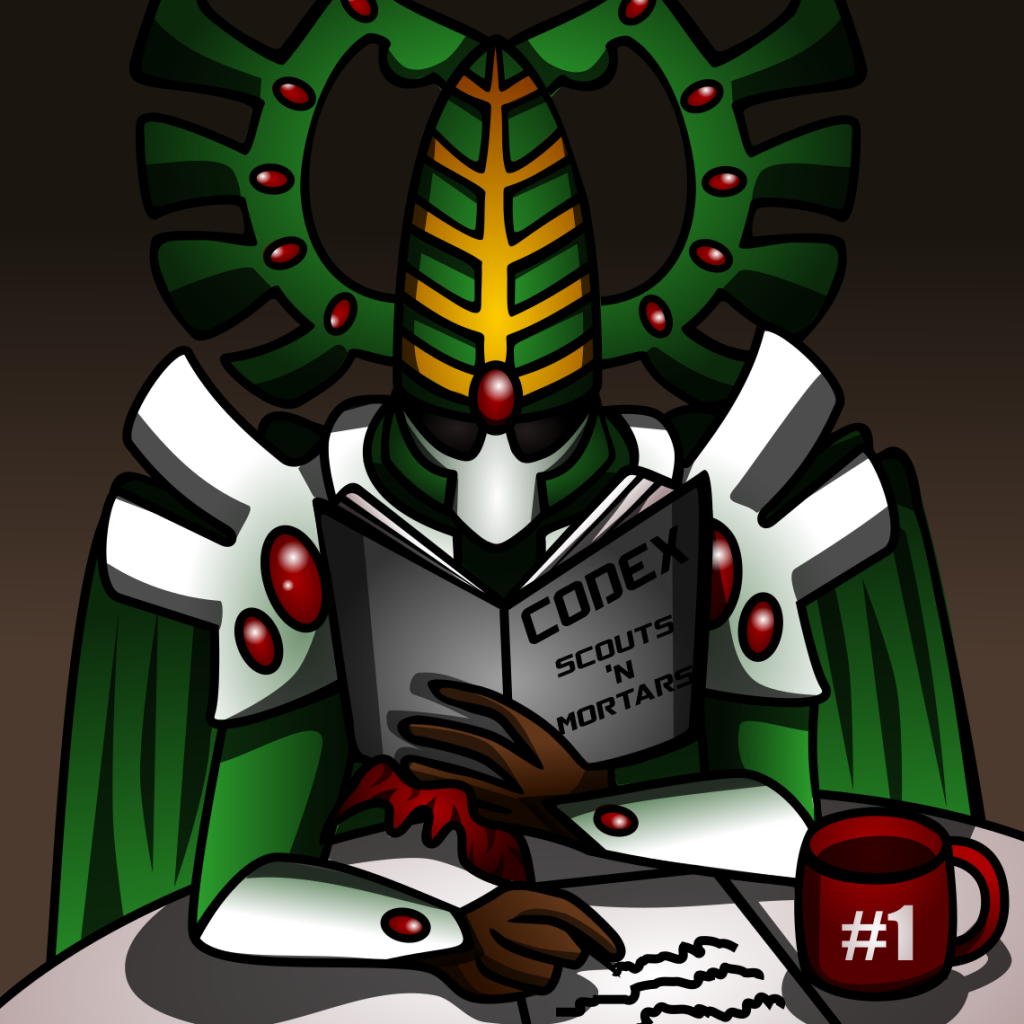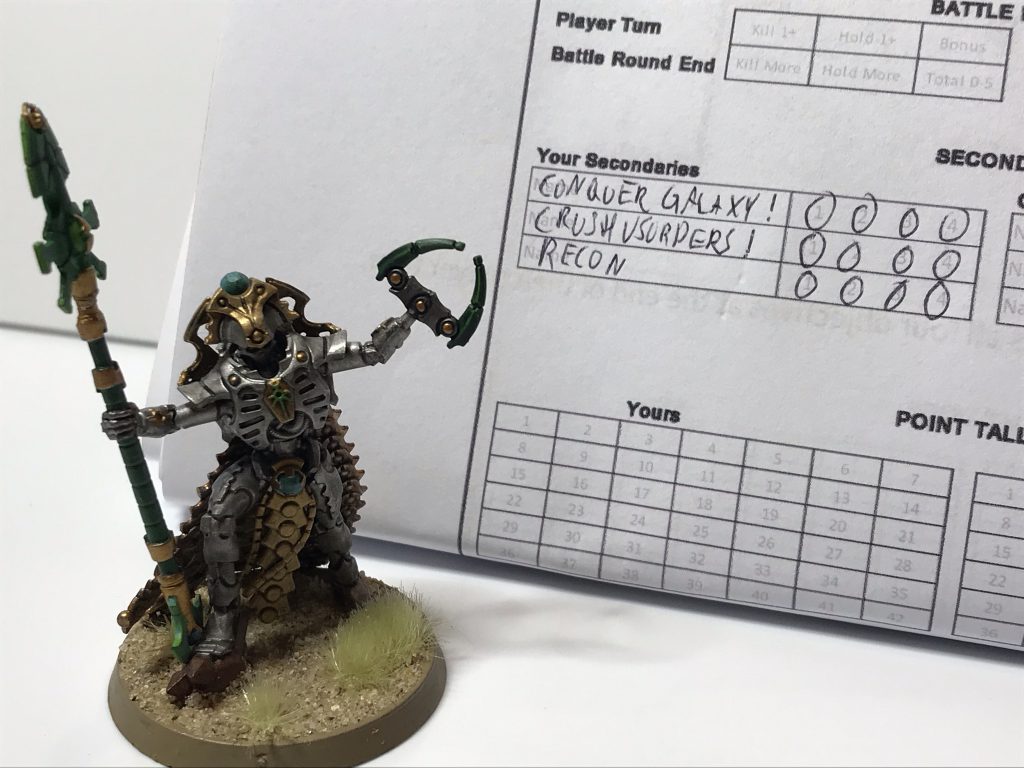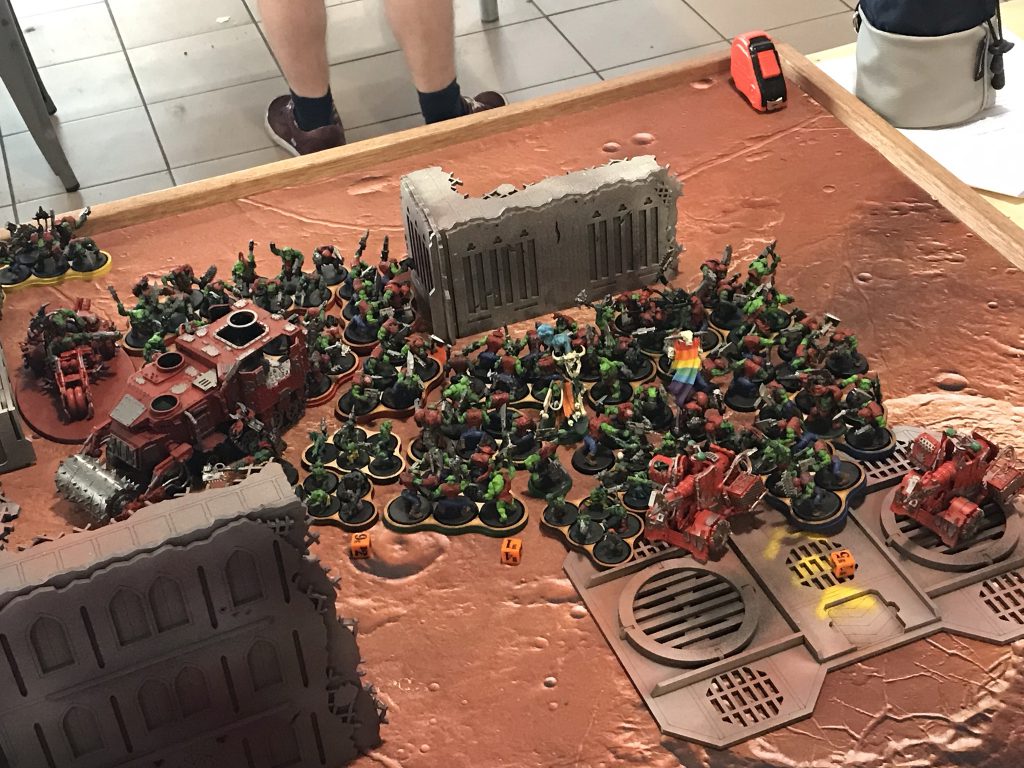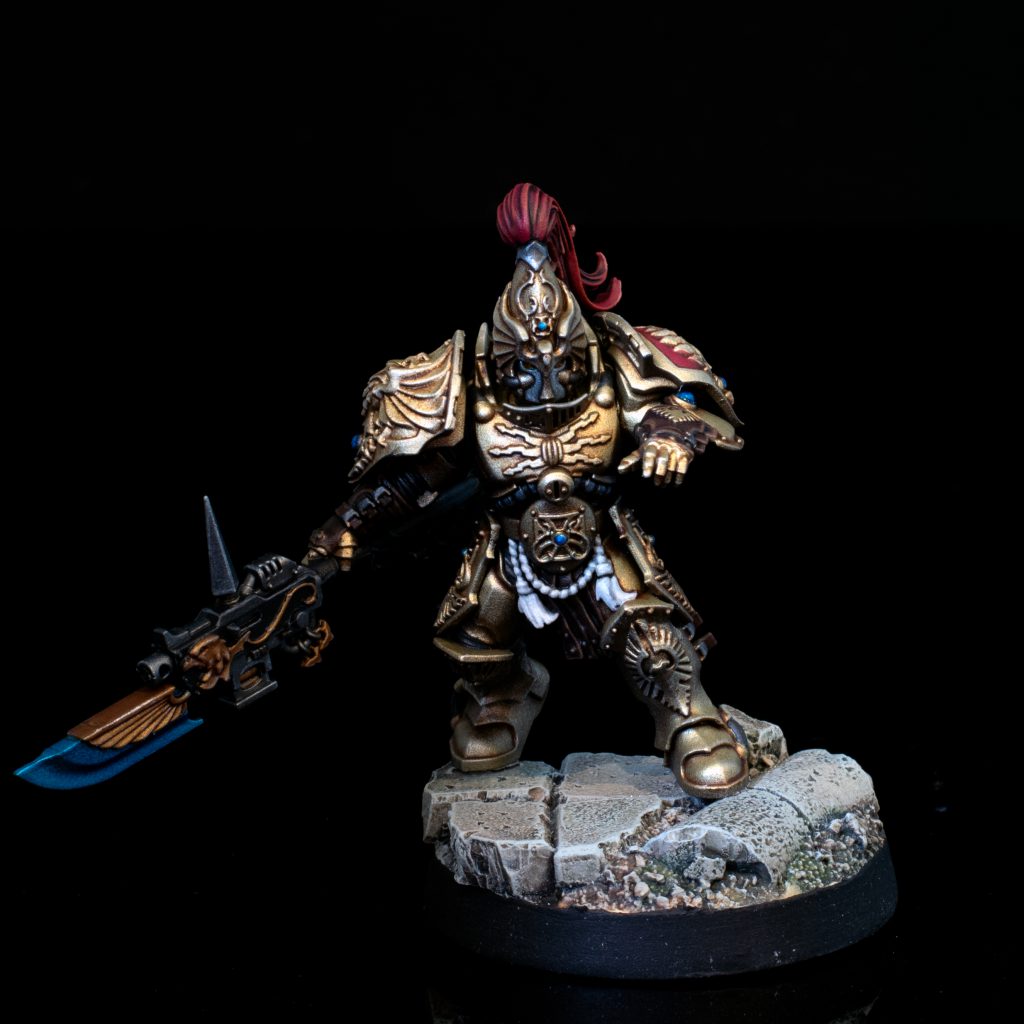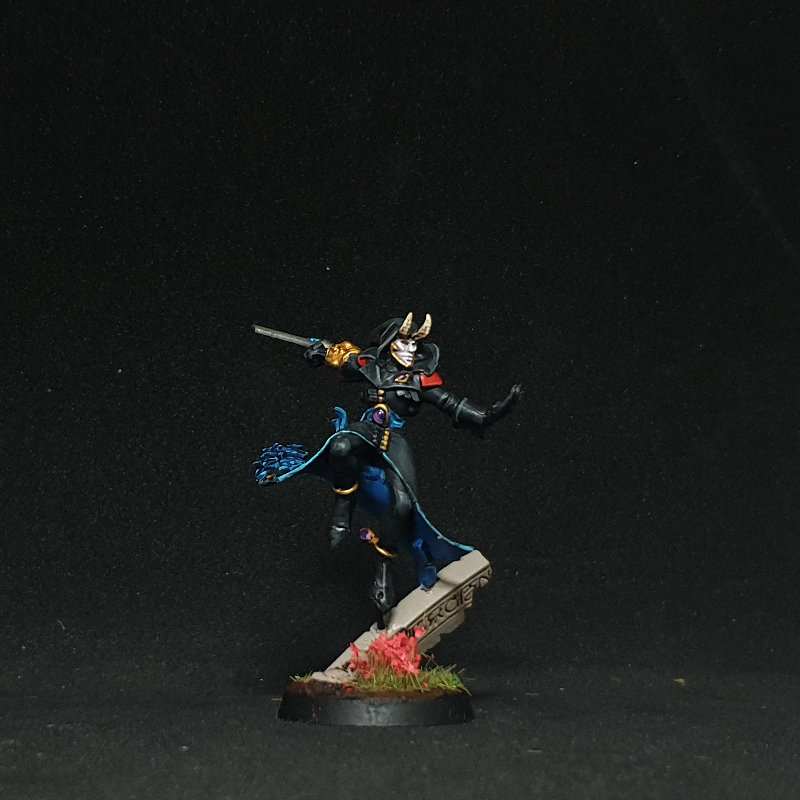Unlike almost all of our editorial team, I’m sadly not going to be able to make the NOVA Open, as I have a prior commitment. With that in mind, I hadn’t really looked at the NOVA mission pack, other than to pick up a vague zeitgeist that they were quite similar to the ITC missions. Then, however, TheChirurgeon suggested that it would be really useful for lots of people (and definitely not just for him, perish the thought) if we put up a brief primer on how the NOVA missions differ from ITC (which, while not the only tournament format, is by far the most common), and how that impacts players’ strategy.
While I really shouldn’t encourage TheChirurgeon to use his content planning role to get me to write bespoke strategy articles for him (TheChirurgeon’s Note: I’m going to keep doing this anyways), it seemed like it could be an interesting intellectual exercise, and probably wouldn’t take that long because after all, they’re just like the ITC missions right? With that in mind, I’ve now had a good old look at the NOVA event pack, and I’m glad I did, because I think there’s quite a bit to unpack here and some major differences worth discussing.
Join me as we go through the rules of the NOVA Open, what’s going to be different for ITC players, what that means for your armies and strategies and then finally do a quick review of my current Craftworld list and what I might consider changing to hit this format.
A big thank you to Naramyth and Boon, both NOVA veterans, for providing feedback and advice on this.
Overall Structure
While, as we’ll see, there’s quite a bit of difference between the NOVA and ITC packs, the overall structures share some strong similarities. Victory is decided primarily based on scoring a combination of Primary and Secondary mission points, with Primary being fairly consistent between the missions, while Secondaries are customisable on a per-game basis at each player’s discretion. While Secondaries are seen as almost the calling card of the ITC, my understanding is that the NOVA Open invented them (or at least that’s certainly what their event pack is telling me) and since then quite a lot of NOVA’s ideas have been absorbed into the ITC format, with some flow in the other direction as well.
Missions/Objectives
While there are plenty of differences in them (which we’ll cover) the NOVA Tailored Objectives are probably the place where the missions are most similar to ITC (being identical in overall implementation to Secondary missions), and I think that’s where the idea of the formats being similar comes from – you pick three before the game begins and can score a maximum of four points for each (and you’re going to recognise some of them if you’ve played in an ITC event or read my article on choosing ITC Secondaries).
When we move over into the Objective Mission, we see a much bigger gap. ITC Primaries encourage you to both consistently attempt to hold objectives and kill stuff each turn, and some elements of the scoring are “zero sum” – each battle round a point is awarded for holding more objectives and killing more units, and only one player can score those. All scoring is centered around turns and battle rounds, and points will always be accumulating throughout a game.
NOVA takes a very different stance on primary scoring. For objectives, players get to customise what their “goal” is, choosing between either “Progressive” (i.e. turn to turn) scoring or instead “Endgame” scoring, in which case they score points for holding objectives at the end of the game. Scoring for Primary Objectives tops out at 18 points, regardless of whether you choose Progressive or Endgame scoring.
Points for killing stuff, referred to as the Decimation Mission, are also in vastly shorter supply than in the ITC format, with a maximum of three points available at the end of the game for destroying various proportions of your opponent’s army (at point thresholds of 500 / 1,000 / 1,500). Units that have lost half of their wounds or more but aren’t destroyed count as half of their points value for the purposes of this total.
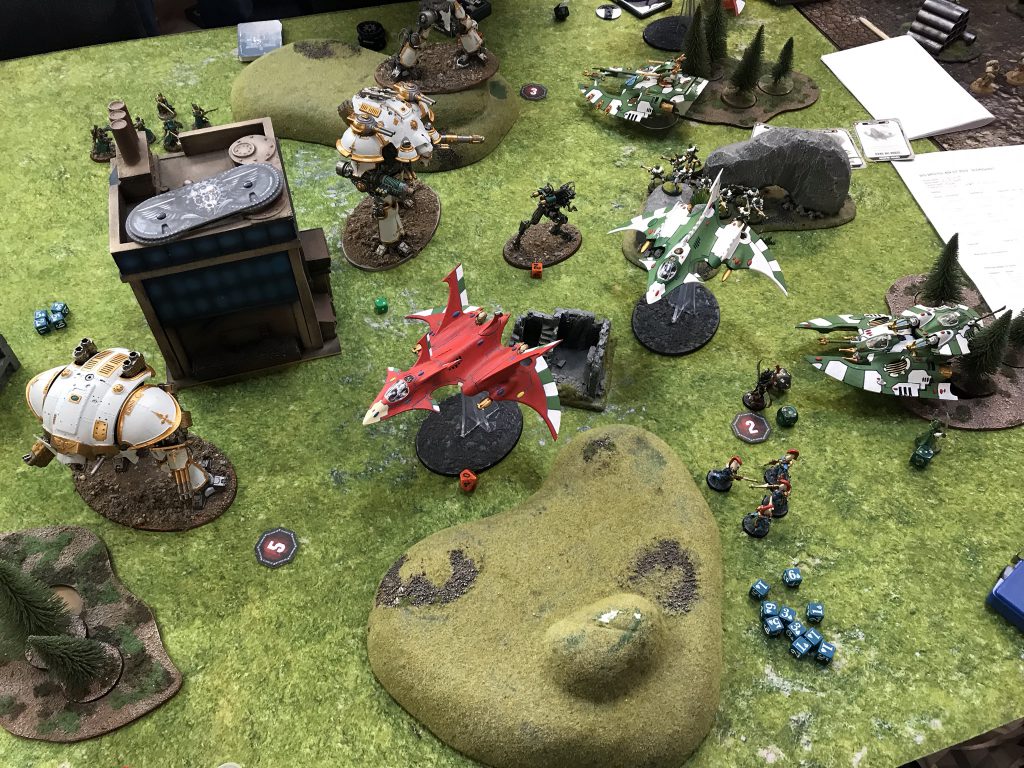
Unlike the ITC, NOVA gives us a format where, in theory, both players could score the maximum of 33 VP in a game (although in practice that’s extraordinarily unlikely). Because NOVA uses a bracket system after the first day, it doesn’t allow a draw to be registered, so in the case of a draw (and with a lower cap there will almost certainly be more of these) the tie is broken by total points destroyed (with units counting for half once half their wounds are gone).
NOVA also differs from the ITC in that each mission has a fixed deployment map. This means you can plan a bit more carefully ahead of time, which may be relevant for some secondaries. It also always has six objectives on the board (with configuration and placement changing round to round), rather than the varied number seen in ITC.
Finally, similar to the ITC, NOVA uses a fixed game length of six turns.
We’ll delve into the precise parameters for all of this in a moment, but just from what we’ve already summarised there are some holistic points to make and start thinking about:
- Tailored Ops/Secondaries are a bigger proportion of the overall points available, so it’s even more important than to max them out. We’ll talk about the specifics of the NOVA ones shortly, but the philosophy of how to pick secondaries from our ITC article will be just as relevant for NOVA as it was then.
- Building up an early objective lead matters less – you can “run out” of points to score after the first four turns, and your opponent can conversely max out their score in the last three or in endgame scoring.
- Scoring maximum points is always within your grasp.
We frequently talk about the importance of having a plan for your games and trying to stick with it, and the NOVA missions are going to reward that like no other – all six turns are going to matter and winning or losing is going to come down to how well you can follow through on a strategic vision for the whole game.
Objective (Primary) Mission
NOVA’s big divergence from other, similar formats is the choice of Objective mission. As part of the pre-game procedure, each player secretly selects “Progressive” or “Endgame” scoring, which is then revealed simultaneously. These give you different goals. There’s also a “Bonus” point available in each mission – a single point towards your total of 18 you can score once, whether you picked Progressive or Endgame.
Progressive
This is the familiar one. If you have selected this, you get the following objective:
At the start of each of of your turns after the first, score points (cumulatively) for each of the following that are true.
- Hold at least one objective – 1pt
- Hold at least 2 objectives – 1pt
- Hold more objectives than your opponent – 2pt
- Hold at least 2+ more objectives than your opponent – 2pt
Right away there’s a big difference from the ITC here – in ITC, you get the equivalent of the first goal at the end of each of your turns, and the third (for a single point) being counted up competitively at the end of the battle round. Here, it’s evaluated separately for each player at the start of their turns. That has some major implications:
- The advantage for primary scoring that exists in ITC for going second doesn’t hold for Progressive NOVA scoring, and for many lists going first will be better. Going first gives you first crack at putting something onto mid-field objectives. In progressive vs. progressive games, the player going first also gets the “last touch” on influencing the scoring of the mission, as on their final turn they can take an opponent off objectives, whereas their opponent’s last turn doesn’t impact the primary at all.
- To score an objective, you need to be able to get onto it and stay there through your opponent’s turn. That means you want stuff that’s either resilient or difficult to target (we’ll discuss this in more detail in a moment). It also means that mobile “troops” units, which are great at sneaking in to rack up points in ITC, are less good for that – they’re still a tool for stopping your opponent scoring, but aren’t as potent for building up your own score.
- Your opponent isn’t “locked out” from catching you up by a strong start. With a maximum of 18pts, you can complete this mission from turns 2-4 by taking and holding 4 objectives – but as long as your opponent has sat on the other two all game, they can max this out on turns five and six.
My gut instinct (and from having played a playtest game with an earlier version of the pack) is that this comes together to encourage a somewhat more measured style of gameplay. ITC is extremely cut-and-thrust: turn to turn you have to make sure you’re at least “treading water” by scoring “Hold 1” and “Kill 1”, and you’re often looking for opportunities to trade expendable units for points, simply because falling badly behind on the primary can give you an insurmountable mountain to climb. Here you’ve got more breathing room – you obviously still want to be scoring early on, but I think you should be weighing much more carefully in the early turns whether it’s worth taking a risk with your unit to secure objectives – if you keep your army intact you can make up the points later, and you can’t usually guarantee that making the play will translate into points, because your opponent gets a chance to stop you.
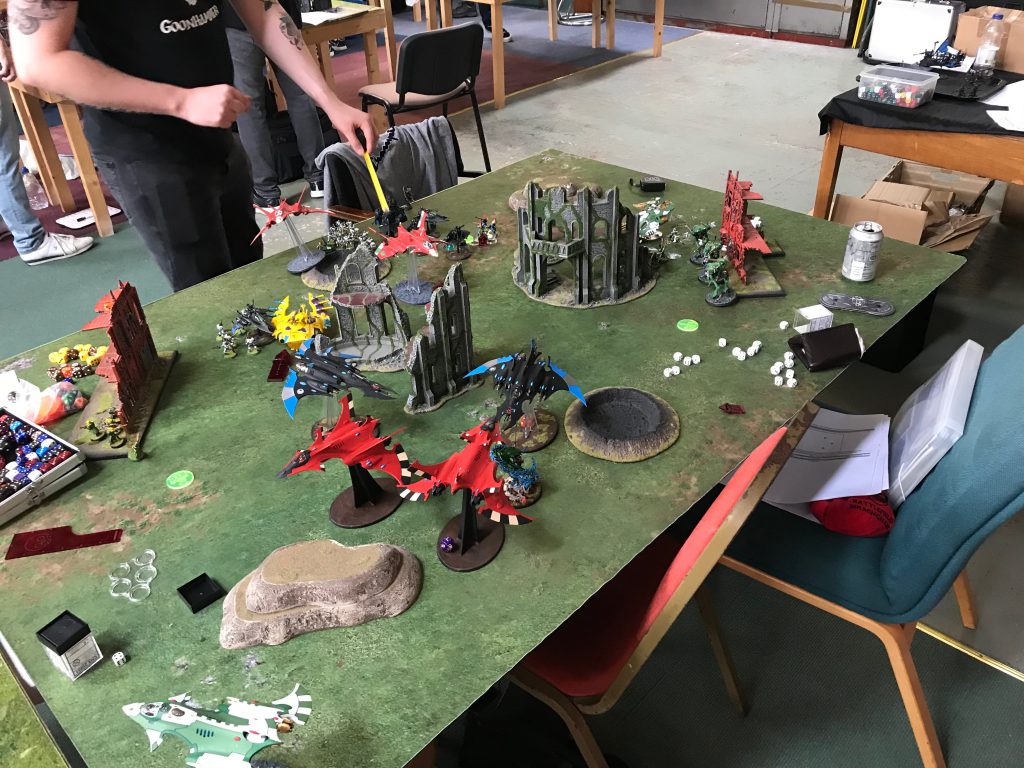
It also elevates some units and diminishes others. Imperium players can no longer rely on going second and yeeting Guard squads onto just enough objectives every turn with “move, move, move” to take the hold more points – Guard are pretty squishy, so once they’ve committed they’re often going to get brutally murdered (as the Emperor intended), making them a lot less good for positive scoring. However, factions that have good value speedy transports they can fill with Troops do very well in this format, as they’re a pain to take off a point. In our playtest game, I went first and pushed two loaded Wave Serpents onto the mid board objectives and my opponent just never really recovered. Craftworlds, Drukhari, Sisters and Ad Mech all have good options to work with this – sadly the Marines’ fancy new Impulsor arrived just too late (it would be extremely good in this format).
Resilient ways to hold objectives are the name of the game, but transports aren’t the only way to do it. Thanks to the character targeting rules, cheap characters are very useful for holding back-field objectives in this format, as unless there are planes flying around you can usually rely on them being safe. There are multiple objective maps in the pack where there are three objectives that could be plausibly regarded as “back field”, and having a trio of characters you don’t mind standing on them will be a good way to keep things under control while you head out. On those maps, you’re going to need to smash a flank of your opponent’s army to start securing “hold more”, so minimising the amount of stuff that needs to stay at home is good. Cheap characters favours Tau, Guard (Move, Move, Moving characters especially) and Sisters, with some Aeldari builds also getting a look in via Death Jesters. Custodes Bike Captains, being ObSec characters that can take a pretty substantial punch (and charge in your opponent’s turn to sneak onto an objective), are also fantastic here.
Finally, resilience can just mean being hard to kill. Knights are famously so, and if I was running them I’d be looking at the traits/relics in both the Imperial and Chaos books that give them access to some sort of ObSec. Talos and Grotesques out of Drukhari are also famously tough to shift, and can do a good job of fighting for an objective.
The other option, of course, is the huge blobs of Orks or Plaguebearers that are popular in ITC. My instinct is that these are a bit less good than normal (more so the Orks). The Ork algorithm in ITC is basically:
10 Push 30 Boyz into opponent's face and secure all the points for a round 20 Opponent spends turn killing 30 Boyz 30 goto 10
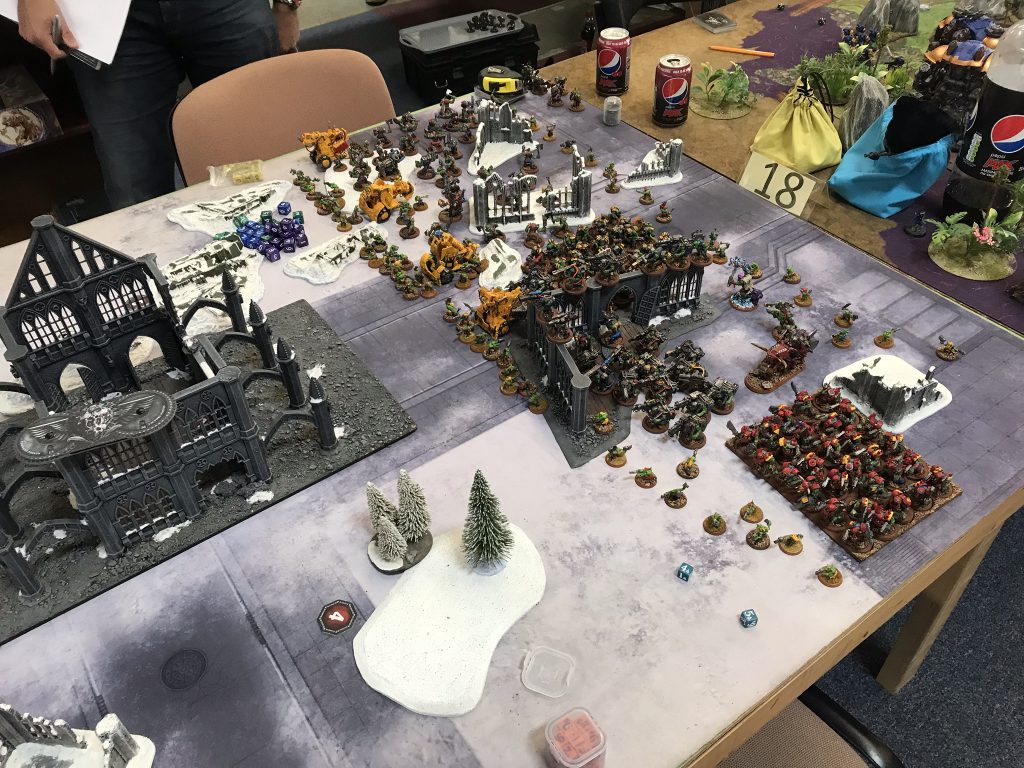
This isn’t nearly as good a plan in NOVA, because if your Boyz are dead before the turn rolls around they don’t score you any points, and Boyz do melt to concentrated firepower. Plaguebearers are (ironically) a bit less melty, but they do still fold to massed fire, and don’t have as many mobility options as the Orks do to cycle new units in. Are these armies still good? I think so, but both at least give me cause for concern – the Orks as to whether their normal trick will secure them enough points against other “go wide” armies, and the Plaguebearer horde for reasons I’ll outline in a second.
The ITC has a varied number of objectives in missions (one with 6, two each with 4 & 5 and one with 3), and different armies tend to do better or worse in different ones. Most notably, low model count armies like pure or nearly pure Knights can suck up their one very bad mission (Seize Ground) and focus on doing well in the rest. In NOVA that’s not true, and 5-6 model armies are going to have a difficult time contesting progressive missions early on some maps. A skilled player might still find a way to make these work, but would need a careful plan to very quickly push the enemy off some objectives (or just delete them) so they can start scoring. Large horde lists, on the other hand, can rely a bit more on naturally sweeping and claiming space to put pressure on their opponent, although the exact extent of this depends on the map.
Having looked at them, there seems to be a broad split in objective/deployment maps between:
- Two “home objectives” each and two “mid-field” (henceforth 2:2:2)
- Three “home objectives” each. (3:3)
Arguably, the first type of map probably gives us games that favour lists in a pretty similar way to ITC (with a few units better or worse as outlined above). Fighting for the board centre is a time honoured strategy in ITC, and in the 2:2:2 missions it’ll still work just fine. The 3:3 maps present some different challenges though, and I think take some popular options, notably Knights and the Plaguebearer list, down quite a few pegs. To do well on primary in these missions, you need to be able to keep hold of your home objectives while pushing your opponent off at least one of theirs, preferably early. Armies that want to bring the bulk of their forces into the centre and stay there most of the game are thus going to be at a disadvantage against any sort of sneaky, speedy army like Aeldari or GSC that can wrap around and threaten their backline. The Nurgle list relies somewhat on holding the centre to be an intrinsically good thing, forcing people to grind their army into the psychic attrition it can throw out. If holding the centre doesn’t win the game any more, what’s it supposed to do?
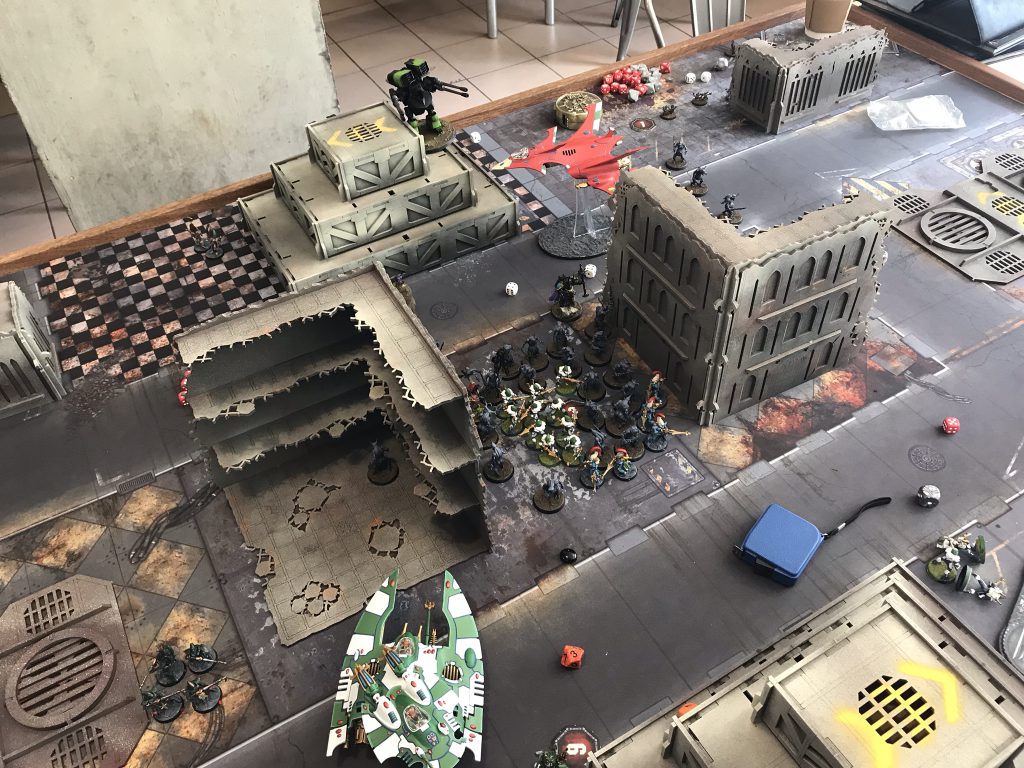
Well, it does have an option that we’ll discuss in a second, but lets just recap what we’ve decided about the progressive option:
- Going first is good.
- Characters, Transports and resilient units are good for scoring.
- Play a bit more cautiously than in ITC.
- Holding the centre matters less for a proportion of the missions.
- You want multiple units you don’t mind leaving back on “home” objectives, as sometimes there are 3.
With that out of the way, let’s look at the endgame option.
Endgame
The endgame mission gives you points for the following:
- 4pts per objective held at the end of the game.
- 2pts if you hold more objectives at the end of the game.
As soon as we start to think about what this asks of you, it starts to look like a tough sell. To max this out, you need to end the game holding four objectives. That means having sufficient units left to do that, and your opponent to be sufficiently on the backfoot that they can’t stop you. Worse, it’s all or nothing – if you get bodied off the board, you leave with 0 primary points (or maybe 1 if you’ve picked up the bonus, but you probably haven’t). It doesn’t immediately seem to get much better when you think about what sort of armies can pull this off. The nature of the progressive missions are such that anything that can reliably sit on two objectives all game (kind of a prerequisite for being on four at game end on first glance) will get 10 points, and if you dunk your opponent by turn four you can reliably make that up to the max.
So…when would we want to take this then? I think the answer comes back to armies that want to play for the centre in the 3:3 maps. The problem they have with the progressive missions on those is that it forces them to deviate from their preferred plan, and their damage dealing mechanisms are optimised for that plan. Knight armies want to be up in their opponents faces, and while I’m going to level and say that I think pure Knights would be suicide at NOVA, even Knights + Loyal 32 or Rusty/Spiky 17 are going to have a tough time maintaining a hold on three home objectives while the Knights go out to do their dirty work – if I took my Eldar against such a list and they picked progressive, I’d just pour my first turns into ensuring that the backline troops were dead. Picking endgame allows those lists to stick more closely to their normal plan of bodying the enemy, and then end-running back to the objectives after, hopefully keeping some of their backline stuff around to take care of at least one of them.
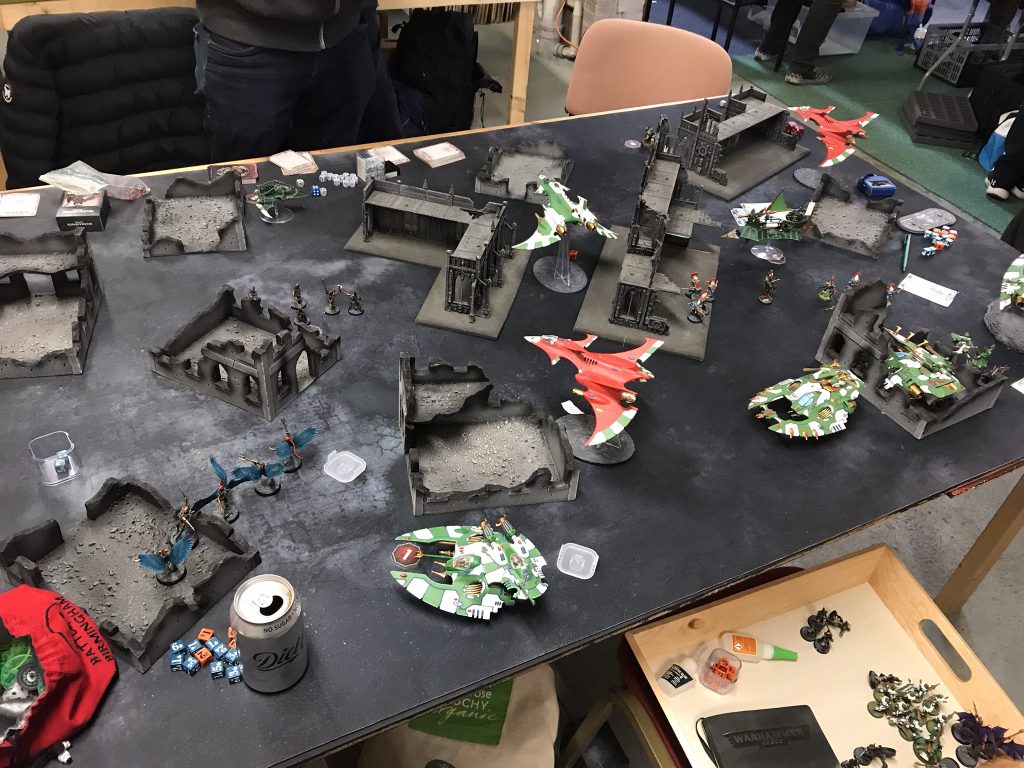
Things like the Plaguebearer list can operate a slightly different plan. When you’re on endgame missions you definitely want to be going second, as it gives you the “last touch” on getting the objectives, and what you can do as an attrition/centre board list is just hold the centre till the end, punish your opponent for trying to do stuff then sweep out in the last few turns to grab the objectives. This isn’t risk free – lists exist that can table 60 Plaguebearers, and against them you need to weigh a judgement of whether picking endgame will grant them too much power to choose how they fight you – but in general it’s a broadly sound plan, and I expect this kind of list on 3:3 maps to be the most common place this gets picked.
If you think you are going to end up picking this, or are at least curious, there are some units that can make it a bit easier. Anything that has an option to leave the battlefield after the first turn and come back, such as Swooping Hawks or GSC (via the stratagem) can become a free four points if you go second, jump them out at some point during the game and precision drop them on objectives on your last turn. You could even bring a Mawloc! Remember Mawlocs? No? Rest assured EU players (including me) were real mad about them in early 2018.
More commonly, mobile characters that can stay safe via targeting most of the game and make a late dash can do this too. If I were bringing Knights with a Loyal 32 I’d look at the option of dropping in a few Platoon Commanders – they’re dirt cheap, and can Move, Move, Move themselves, letting them help with holding backline objectives if I pick progressive in 2:2:2 maps, and make a strike for objectives over turns 5 and 6 on 3:3 maps. Missile pod Coldstars in Tau are a great choice for this too – they can contribute to volume firepower most of the game, and then zoom 40″ onto the objectives at the end of the game. Standard castle Tau lists are otherwise pretty up against it in this format, and if I were planning to bring one I’d almost certainly be looking to have 2x missile Coldstars on top of the practically mandatory Shadowsun.
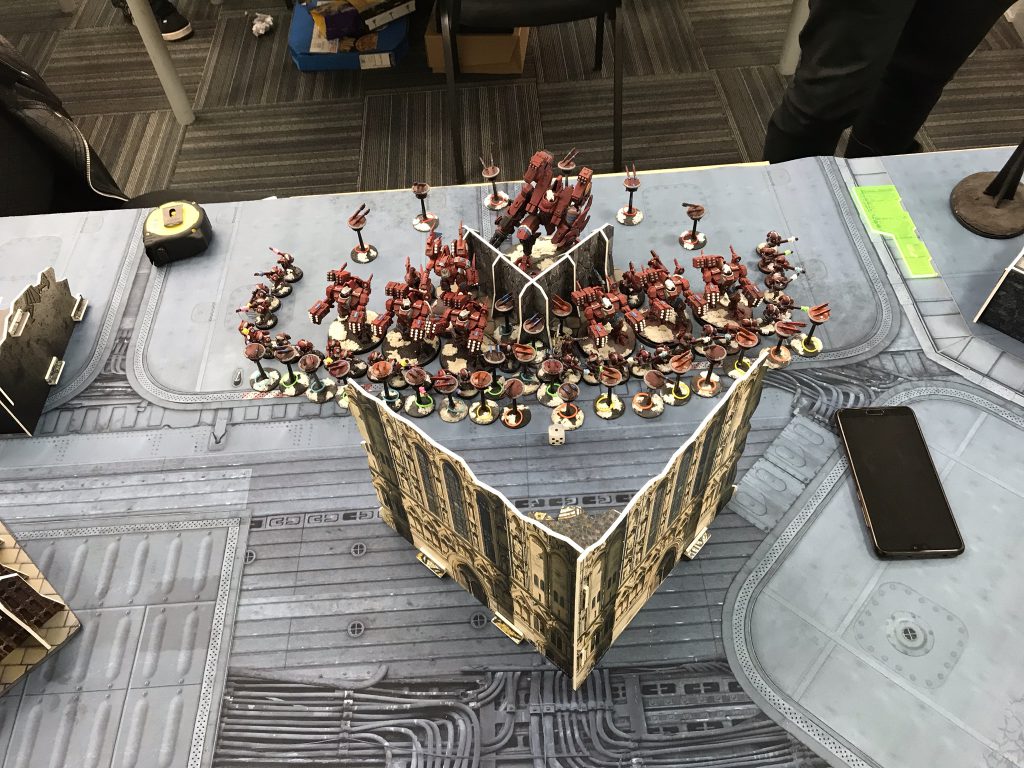
Ultimately, I expect picking endgame to be the exception rather than the rule. You have to remember that you’re unlikely to be able to fully opt out of playing the progressive missions – because if you cede the field to your opponent they can just max out their primary. You’re likely wanting to aim at holding two objectives and removing your opponent from two a lot of the time in order to minimise how many points they rack up – and if you’re managing that, you’d have gotten a pretty good score from the progressive primary at a lower risk.
Sometimes, it’s still a risk you’ll have to take. Pure castle lists (like some Tau builds), centre control lists on 3:3 maps and low model-count armies up against deep strike hordes might look at a game and decide that a strong endgame score is their best chance of competing on the primary, meaning this does have a strategic role to play.
If you are doing this, you obviously want to go second – so if your opponent has picked it and you win the roll, putting them on the first turn can be a helpful counter to mess with their plans.
Overall, our summary of why you might want to pick this is:
- You want to form a pure castle, either based on your list or the matchup.
- You just cannot compete with your opponent’s army on board control until you’ve wiped out most of it (often a sub-set of the above).
- Your army plan is to dominate the centre on a 3:3 map.
- You have sneaky plans to steal objectives on the final turn.
Bonus Point
Every mission offers you a single bonus point you can score towards the objective mission. These usually take the form of “hold <permutation> of opponent’s home objectives at the start of your turn”.
I think this was a bit more interesting in the draft of the pack where the score limit was 12 but the missions were substantially harder to score. With 18 point primaries that are a bit easier to max, it matters less. That doesn’t mean you shouldn’t try and score it if you can – why not – but it’s not like ITC where finding a route to start cashing in the bonus early is a top method to put pressure on the opponent. My read on these as it stands is that the conditions are sufficiently tough enough that it’s extremely unlikely for you to be pulling them off without being on a trajectory to max your primary anyway. Grab them if you can, but don’t suicide a unit for it.

Tailored Op (Secondary) Missions
In each game you choose three secondary missions to go with your primary, and can score up to four points for each. You make your selections after seeing your opponent’s army at the same time as picking between the two primary missions. All but one of these will look fairly familiar to ITC players, as there’s a decent amount of overlap, but many of NOVA’s versions differ, being slightly more or less challenging to pull off, and making a few particular units a bit less of a liability than they are in the ITC.
As with the ITC, missions where you’re going after “specific” targets (either categories of units or designated ones) won’t “stack” with one another, so you won’t be able to score a point towards two secondaries for killing the same unit. However, they’re a bit more lenient on some of the less “targeted” ones than the ITC is, so in some matchups clever choices will let you get rack up multiple points quite easily.
We’ll go through each secondary, compare it to the ITC equivalent, pick out some good targets for it, then talk at the end about what kinds of units/armies will do better in these than in the ITC.
Moment of Bloodshed
Objective: Destroy 2+ non-Troop units in a battle round.
ITC Comparison: Similar to “Butcher’s Bill”, but doesn’t allow you to go after troops (see “Strike the Rank and File” later for where that’s ended up). However, it does let you stack it with targeted kill missions, whereas Butcher’s Bill is non-stacking in the ITC.
Consequences:
If your opponent has a mixed force and you’re planning to table it while racking up something like “Shoot the Big Ones” on the way, this is considerably more attractive than the ITC equivalent. It’s less good against some of Butcher’s Bill’s normal targets, most of which will get covered by “Strike the Rank and File” but one notable one (Drukhari Venom Spam) dodges a bit, as you can’t score it by killing a Venom and the Troops inside.
Do give a bit of thought to how many non-Troops units your opponent has, too. You need to space killing them out across at least four turns and hit two on each, so if they only have 10-11 I’d be legitimately worried about messing up and missing a point.
Cull the Hordes
Objective: Destroy 20 models
ITC Comparison: Pretty much identical to ITC Reaper, right down to (effectively) not stacking with Marked for Death
Consequences: Reaper is one of the easiest objectives to max in the ITC in favourable matchups, and that’s just as true here. If it looks like it’s great, it’s probably great and you should pick it.
Breakthrough
Objective: Have a unit wholly in your opponent’s deployment zone at the start of your turns (they clarify “wholly in” as meaning “every model partially in”).
ITC Comparison: Identical to ITC “Behind Enemy Lines”
Consequences: As we’ll see in a second, NOVA’s Recon is slightly harder than ITC’s, so I expect this to be considered more often. The fact that primary objectives are scored at the start of the turn also makes the fact that this is “start of the turn” less of a liability, as your opponent is already potentially going to have things they want to prise out of certain positions to worry about.
Another point is that while you technically pick ITC secondaries after deployment map is rolled, people often pick beforehand, and even if they don’t will be quite “on the spot” to make a decision, which usually makes a “riskier” secondary like this less common. As the NOVA missions used fixed deployment, you’ll be able to start thinking about whether this is a good pick against your opponent from the moment parings go up in BCP, making spotting good times for it easier.
Reconnaissance
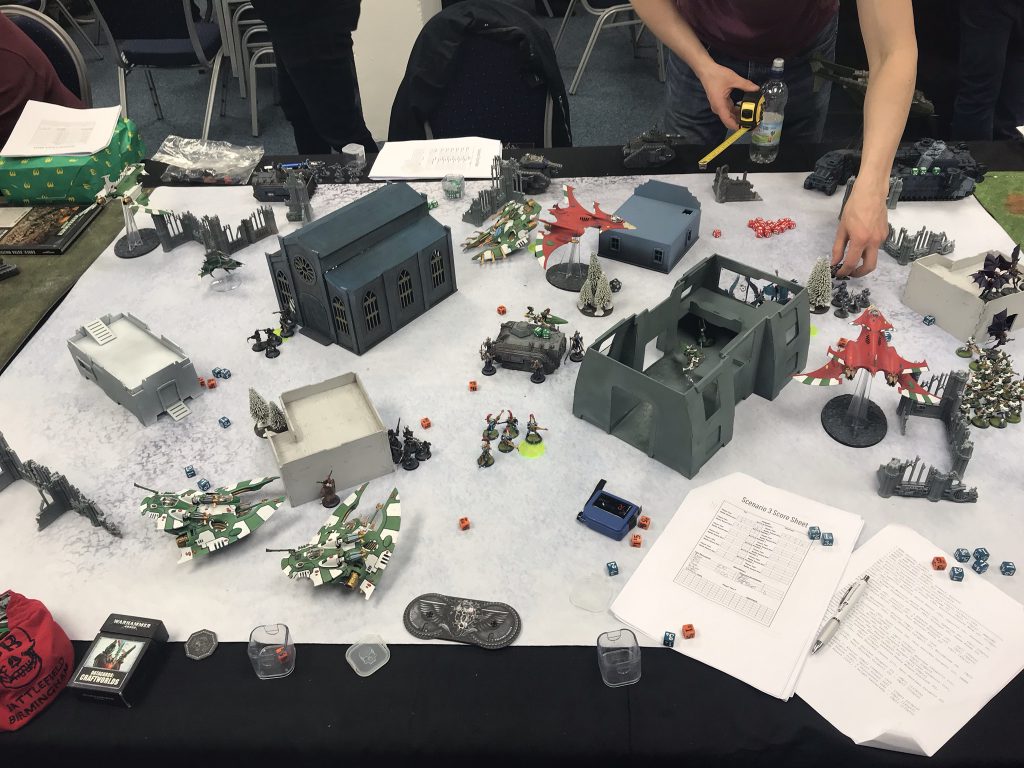
Objective: Have a unit wholly within each table quarter at the end of your turn for a point.
ITC Comparison: Harder than the ITC’s Recon, which requires a unit only partially within each quarter.
Consequences: Reconnaissance being fully under your control still makes it a reliable pick for some armies, but the difference here is actually surprisingly big, and makes things like “Breakthrough” look more attractive. Common armies that pull of Recon in the ITC are:
- Hordes – they only have to push one model from a unit into a quarter to claim it, which is trivial, and also easy to set up via charge move tricks.
- Knights with a loyal 32 – the ground forces can usually cover two “home” quarters, while the Knights push into the “away” end.
- Eldar with planes – planes go fast.
All of these take at least a bit of a knock here, though the severity varies. Hordes take the biggest hit – getting the whole of the kind of 30-model units often used to cover this out into a quarter is likely prohibitively hard (though if they’ve got a strong character presence they can still potentially make use of this). Knights are also hurt a lot – a knight engaging on the dividing line between quarters can no longer selectively pick which one they want to count for, and their bases are big enough to make this a bit of a pain.
Only Eldar fliers can still do this comfortably, and it still hurts them. Because of the size of flyer bases, it’s often advantageous to just “nose” one into a quarter to minimise how far you have to thrust them away, and allow them to double-duty as deep strike screening. The metagame contains plenty of armies that will punish a flyer that comes too close, and plenty that want to use deep strike to their advantage.
Further dictating where a flyer has to end up to pull this off does make it less attractive (assuming the fact that this uses different wording from Breakthrough is deliberate), and I already find myself hesitating to pick Recon in some ITC matchups because of how much it constrains me. It would still be on my list as a reliable fallback, but I’m less enamoured of it here.
Old School
Objective: Score one each for:
- First Strike – kill a unit in the first Battle Round.
- Last Strike – kill a unit in the last Battle Round.
- Slay the Warlord
- Linebreaker – Have a model in your opponent’s deployment zone at game end.
ITC Comparison: Identical to ITC Old School
Consequences: Still less of a safe pick than people think (see my rants about this in the ITC article), but still good in some matchups, and a bit more attractive here because “Moment of Bloodshed” stacking with things like “Shoot the Big Ones” makes planning out a high scoring kill route through your opponent’s army that bit easier.
Strike the Rank and File
Objective: Destroy 2+ Troop units in a battle round to score a point, and score a point at the start of any turn where no troops exist.
ITC Comparison: None
Consequences: If we needed any more persuasion not to bring pure Knights, here it is. If your opponent rocks up with an army without Troops, this is four free points. If they only have a minimal number of Troops and you think you can take them all out by turn 3, then you can still pick it and go wild, just remember that you’re putting yourself on a clock.
This one has gone back and forth on implementation and if I’m honest I’m not wild about what they’ve ended up with. This is deceptively painful to score – it would be very easy to pick this against an opponent with just three Troops choices, for them to find a way to hide one, and to get stuck with only one or two points here. To score it “naturally” requires an absolute tonne of Troops units down against you, and while some such lists do exist, they’re pretty rare. I think this is a freebie in a few matchups, but is very often going to be a trap choice in some where it feels like it should be good.
Marked for Death
Objective: Pick four enemy units. Destroy them for a point. You can’t pick TROOPS if you picked Cull the Hordes or Strike the Rank and File. Doesn’t stack with any of the “kill specific thing” missions, but does stack with “Moment of Bloodshed” (I think? It doesn’t have an asterisk?).
ITC Comparison: Similar to Marked for Death, but with no PL restrictions.
Consequences: Like ITC Marked for Death, but better. This will get picked a lot, and honestly I think it’s a vastly safer way to punish your opponent for turning up with a few troops than Strike the Rank and File. Alternatively, there are tonnes of lists where your first kills are just obvious and this is free points. How often have you seen a Guard brigade’s three Sentinels last beyond like turn 2? That’s 3/4 right there. Facing Tau? Are their Shield Drones spread over at least four units? Ding ding Venom spam? Free points.
I harp on about picking secondaries that align with your “critical path”, and this makes doing that incredibly easy. Pick early, pick often.
Shoot the Big Ones

Objective: Kill a model with 10+ wounds for a point.
ITC Comparison: Big Game Hunter (7W)
Consequences: Big Game Hunter, but doesn’t heinously punish Talos. Still good in pretty much all of the other matchups where Big Game Hunter would have been good, and like Marked for Death, stacks with “Moment of Bloodshed” if you have a clear plan to scythe through a specific subset of units.
Headhunter
Objective: Kill a character for a point.
ITC Comparison: Identical to ITC Headhunter
Consequences: Just take a look at the ITC secondaries article – this is exactly the same and good in the same places.
Titanslayers

Objective: Kill a Titanic model for 2pts
ITC Comparison: Harder version of ITC Titanslayers (which is “inflict 8W on a TITANIC model”).
Consequences: In theory this is harder than Titanslayers, but ultimately it’s good in the same places – your opponent has multiple TITANIC models (usually Knights) that you want to kill. More likely to go against you in a close game, but the lack of Kingslayer means you’ll be shorter of choices against Knights, so you’ll have to deal with that.
Engineers
Objective: Pick two non-character units from your army to be your engineers. From turn 2, if either starts and ends your turn within 3″ of the same objective marker, and makes no attacks and manifests no psychic powers, gain a point. They can’t benefit from anything that makes them untargetable.
ITC Comparison: Identical to ITC engineers (though I’m like 95% sure they took it from NOVA).
Consequences: Much the same as it is in ITC – pay attention to your matchups, and watch out for places where this is good. Because there are fewer secondaries available, this will likely be picked a bit more, and when it’s good it’s pretty great. However, the terrain layout and objective maps don’t look super forgiving for this, and I’m fresh off a tournament game in ITC where I took out all of my opponent’s engineers on turn 2, so make sure you apply a sufficient level of scepticism before plumping for this.
The Notable Absences
A couple of ITC secondaries have no equivalent here in a way that’s quite impactful. These are:
- Gangbusters. This makes powerful multi-wound units way better, and buffs (among other things):
- Custodes Bikes
- Kataphrons
- Ironstriders/Dragoons
- Harlequin Bikes
- Talos
- Grey Knight Paladins
- Kingslayer. This buffs:
- Single Knights (they no longer get punished for taking relics/traits)
- Bike Warlords
- All the kingslayerable Named Characters (Magnus, Marneus, Abaddon, Cawl)
Everything above is some degree of liability in ITC – it’s all stuff your opponent is definitely going to want to kill, and will get to max a secondary on the way. Not giving up a free secondary makes them quite a bit more useful, and lone Knights, having gone just the faintest bit out of fashion in recent months, should be all over the place as including one really only makes your opponent’s life harder, secondary wise.
The Takeaways
Most of the consequences of this are outlined above, but what I think this comes together to mean is:
- Building a secondary denial list is way harder. Gangbusters has already made this way tougher to do in ITC, and ironically here only stuff that normally falls foul of Gangbusters can easily muster one – at least without making a list that struggles with the Primary.
- Having a plan to score at least one of Breakthrough or Engineers is important. There are fewer secondaries available, and Recon is much tougher for normal armies to do, meaning you’re more likely picking these in some games against lists that have tailored to be a bit less vulnerable.
- Moment of Bloodshed stacking changes the dynamic of kill objectives quite a bit – keep an eye out for being able to construct a fairly “straight line” kill plan through your opponent’s army to max points – just make sure that spacing out the kills is realistic with the “non-troops” rider.
Decimation (Tertiary) Mission
The final points that are available are points for killing stuff. You get up to three points for meeting the following thresholds:
- 500pts of the enemy army destroyed.
- 1000pts of the enemy army destroyed.
- 1500pts of the enemy army destroyed.
Units that have lost half their wounds count for half their points.

A bit like with the primary missions, this felt more relevant in the version of the pack where the primary cap was 12, but at 3 points you do want to try and score it. Realistically though, the main impact of this compared to ITC is that it means the ongoing “kill 1” and “kill more” primaries from that aren’t in effect.
My feeling is that “all rounder” armies intending to play a fairly normal game of 40K don’t have their plans affected much by this. The ones it hurts are:
- Low output armies that aimed to kill exactly one thing a turn to tread water in ITC. The popular Daemon list often plays out like this, as covered by Matt Root.
- High threat/precision armies that lean on being able to get “kill more” to avoid ending up behind on primary against armies they can’t afford close engagement with. I don’t like this picture because I am in it.
To more seriously expand on that latter point, I’ve played plenty of ITC games where my calculus has been that my safest option is to pick kill-focused secondaries, largely castle up on one objective, then focus on ensuring I hit kill more every turn until the enemy is sufficiently depleted for me to sweep up the primary in the last few turns. That is still technically an option – I could go on the same plan by picking endgame objective missions, but it’s waaay higher risk, because if it goes wrong then I definitely just lose.
As we’ll see in a sec though, I think my list adapts pretty well to the primaries here, but this is horrible for the 9 plane lists, for whom “kill stuff while holding a few objectives” is the main plan, not a fall back for certain matchups. A general theme that’s emerging as we go through this is that the plans of some of the really heavy skew lists that do well in ITC just don’t hold up here – having to have a resilient, game-long plan to control the whole board really matters here, and part of making a skew list work in ITC is usually finding some sort of loophole so you don’t have to do that.
It’s also probably the final nail in the coffin for low model count lists. One of the advantages pure Knights have in ITC is that your opponent pretty much only gets “kill more” in the turn they table you. Here, even that advantage is gone.
On a more positive note, this does elevate a few things – notably small, squishy units are less of a points liability here, so can be taken with a bit more impunity. Combined with the fact that I find “Strike the Rank and File” somewhat clunky, I’d be a lot less hesitant to scatter some random Kabalites in my backline to control space and hold my home objectives while my army goes out to play. I’d also look a bit more fondly on stuff like support weapons, where in ITC the fact they split into extremely squishy individual units is a big mark against them. Given that “easy kills” is one of the few things holding Ork Smasha Guns in check in ITC, I wouldn’t be surprised to see them making a bit more of an impact.
Overall Impact
With our tour of the rules and some individual impacts out of the way, it’s time to put my reputation on the line and make some predictions about who wins or loses in this format. Here are some of the things I think go substantially up or down in power:
Winners
- “Balanced” Lists: Objective scoring rewards these far more than it does in ITC, and they’re the most likely to be able to shrug and move on from the differences in kill scoring.
- Custodes: They’re one of the few viable “secondary denial” lists in the format, as a list heavily skewed to bikers with exactly three vehicle targets (you know the ones I mean) is a real pain to pick against. They also have a bunch of durable, mobile, ObSec stuff.
- Mechanised Lists: Eldar Wave Serpents are the obvious beneficiaries, but some Chimera spam Guard lists have been doing well in continental ETC events, and probably have game here. Sisters or Ad Mech could also put together something very well tuned for the format.
- Auxiliary Knights: Without Kingslayer, the penalties for bringing a lone Knight are vastly reduced, and it gives any army a resilient, powerful threat. Expect to see the Krastsader and the Dreadblade Iconoclast Double Gat build out and about a lot, as those are the most “configurable” builds for loyalists and Chaos.
- Drukhari Covens: Grotesques are popular in ITC, but Talos have always been held back a bit by how badly they leak secondaries. Here they don’t, and I’d be much hotter on bringing some.
Losers
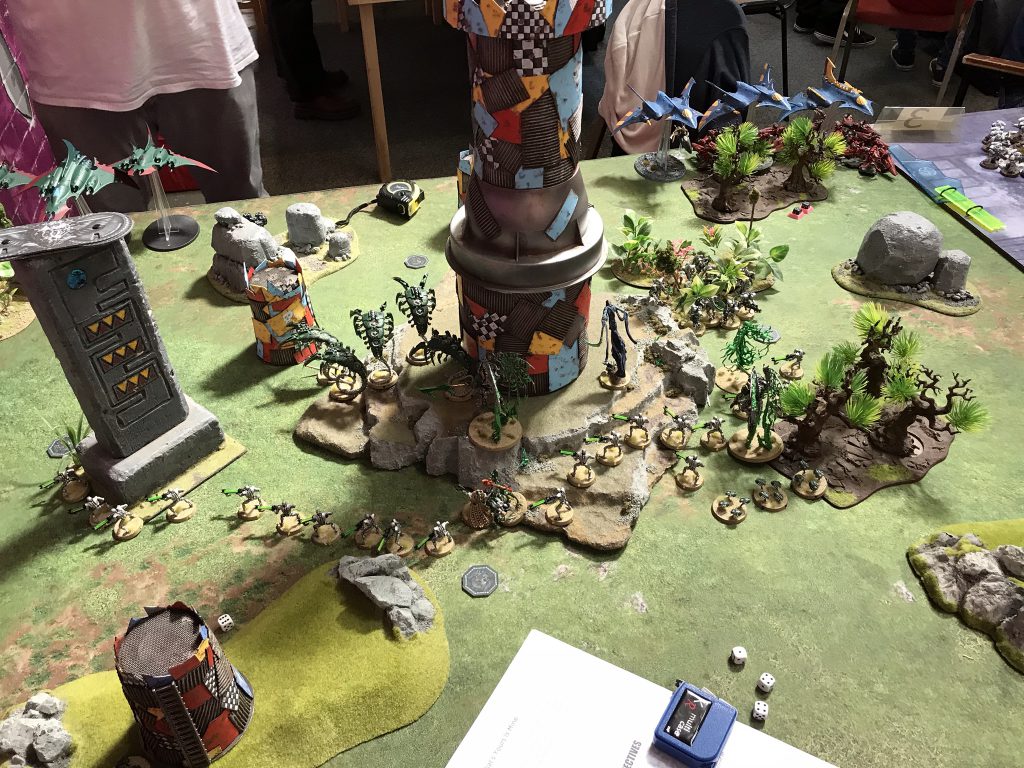
- “Skew” Lists: The objective scoring is way harder to “target” by attacking it in a specific way, so lists that rely on doing that in the ITC are going to have a tougher time. It’s also way harder to build to deny secondaries (an element of many skew lists) without kneecapping your own ability to score primaries.
- 3+ Knight Lists: Our first notable loser on that count. I would not bring pure Knights to NOVA. Full stop. If I was bringing Knights, I’d explore mitigating my weaknesses by taking one of the builds that packs a Loyal 32 and a Rusty 17 (or one of the builds that expands one of these with some alpha units), as adding a bunch of kill targets just isn’t as much as a drawback here.
- Plane Spam: Good riddance. 6 Plane lists with 3 Crimson Hunter Exarchs and 3 Razorwings are probably still fine, as they’re very efficient engines of death and have plenty of points left for ground coverage, but the 9+ plane abominations are out, which is good, because they’re just the worst. They’re probably ahead of even the hated Caladius as “thing I would like to see something done about” and I’m an Eldar player.
- The Nurgle/Thousand Sons list: Saving the hottest take for last. It’s still good, obviously – it belongs in the hall of fame alongside some previous nasties as one of the best lists 8th edition has thrown up, but it’s highly tailored to the ITC format and some of what makes it good just doesn’t apply here. I’m sure it will still see strong finishes, as the people who made it famous are also some of the best players in the world, but I wouldn’t be surprised to see more copies of it much further down the bracket, as players without the experience to adapt to a different environment find it underperforming for them.
Much Ado About Space Elves
So, with all of that in mind, if I was going to NOVA (weeps quietly) what would I do to my list?
My current build, fresh off a good finish at the London Open, is as follows:
Army List - Click to Expand+ ARMY FACTION: Asuryani
+ TOTAL COMMAND POINTS: 13
+ TOTAL ARMY POINTS: 1999pts
+ POWER LEVEL: 118
+ ARMY FACTIONS USED: Asuryani, Alaitoc
+ TOTAL REINFORCEMENT POINTS: N/A
+++++++++++++++++++++++++++++++++++++++++++++++++++++++++++++++++++++++++++
== Battalion Detachment == Alaitoc [72PL, 1104pts] +5CP
HQ: Farseer (110), Witchblade (0), Remnant of Glory Faolchu’s Wing [6PL] [110pts]
HQ: Spiritseer (65) [3PL] [65pts]
TR: 5 Dire Avengers (40), Exarch (0), 5 Avenger Shuriken catapults (15), Exarch Additional Avenger Shuriken Catapult (3) [3PL] [58pts]
TR: 5 Dire Avengers (40), Exarch (0), 5 Avenger Shuriken catapults (15), Exarch Additional Avenger Shuriken Catapult (3) [3PL] [58pts]
TR: 15 Guardian Defenders (120), Heavy Weapon Platform (5), Scatter Laser (7) [9PL] [132pts]
HS: Night Spinner (110), Twin Shuriken Catapult (2), Crystal Targeting Matrix (5) [8PL] [117pts]
HS: 3 War Walkers (120), 6 Scatter Lasers (42) [12PL] [162pts]
DT: Wave Serpent (120), Twin Scatter Laser (12), Twin Shuriken Catapult (2) [9PL] [134pts]
DT: Wave Serpent (120), Twin Scatter Laser (12), Twin Shuriken Catapult (2) [9PL] [134pts]
DT: Wave Serpent (120), Twin Scatter Laser (12), Twin Shuriken Catapult (2) [9PL] [134pts]
== Battalion Detachment == Alaitoc [18PL, 349pts] +5CP - Specialist Detachment - Windrider Host -1CP
HQ: Autarch Skyrunner (95), Laser Lance (8), Fusion Gun (14), Twin Shuriken Catapult (2), Banshee Mask (0) [6PL] [119pts]
HQ: Warlock Skyrunner (65), Twin Shuriken Catapult (2), Witchblade (0), WARLORD - Seer of the Shifting Vector [4PL] [67pts]
TR: 5 Dire Avengers (40), Exarch (0), 5 Avenger Shuriken catapults (15) [3PL] [55pts]
TR: 5 Rangers [3PL] [60pts]
TR: 8 Storm Guardians (48), 2 Chainswords (0), 6 Aeldari Blades (0) [3PL] [48pts]
== Air Wing Detachment == Alaitoc [28PL, 546pts] +1CP
Flyer: Hemlock Wraithfighter (200), Spirit Stones (10) [10PL] [210pts]
Flyer: Crimson Hunter Exarch (135), 2 Bright Lances (40) [9PL] [175pts]
Flyer: Crimson Hunter Exarch (135), 2 Starcannons (26) [9PL] [161pts]
How might we tweak it?
Option 1 – Do Very Little
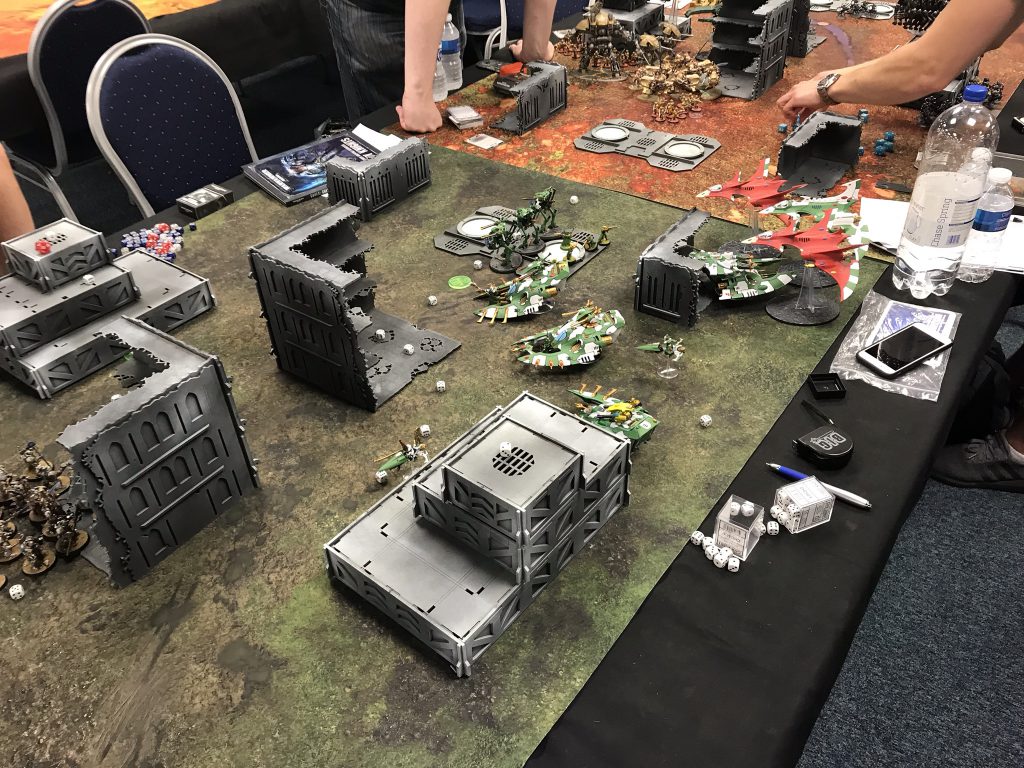
Entirely by accident, this list is actually pretty damn good in the NOVA format, mostly because It’s got that third Wave Serpent full of Storm Guardians, and an additional character who adds to the mobility of others (the Spiritseer, who pretty much always picks Quicken). Part of the reason I haven’t joined the 6 plane club, despite recognising it as very powerful, is that it doesn’t give the kind of games I like to play – I like running balanced lists that can adapt to the situation and game at hand, and the above is basically the culmination of a year of tuning an Eldar build to do just that. It’s got multiple things I don’t mind holding back on a home objective (War Walkers, Night Spinner) while the Serpents head out to conquer the mid board. The only place that plan might start to creak slightly is on a long-edge map with three home objectives against a heavy push build like horde Orks – I don’t realistically thing I could deploy to defend three, so I’d have to start on 2 and adapt from there.
If I was looking to make tiny tweaks, swapping the Night Spinner for three separate Shadow Weavers might be worth it (I have the slots over two Battalions). Not leaking kill points makes them way better, and they let me cover more ground in the backfield. Technically they’re good Marked for Death targets, but realtalk no one is ever failing that against me. I’d also probably make my Autarch the warlord, as without Kingslayer he’s not such a liability at that point.
Option 2 – Bring the Drukhari Back
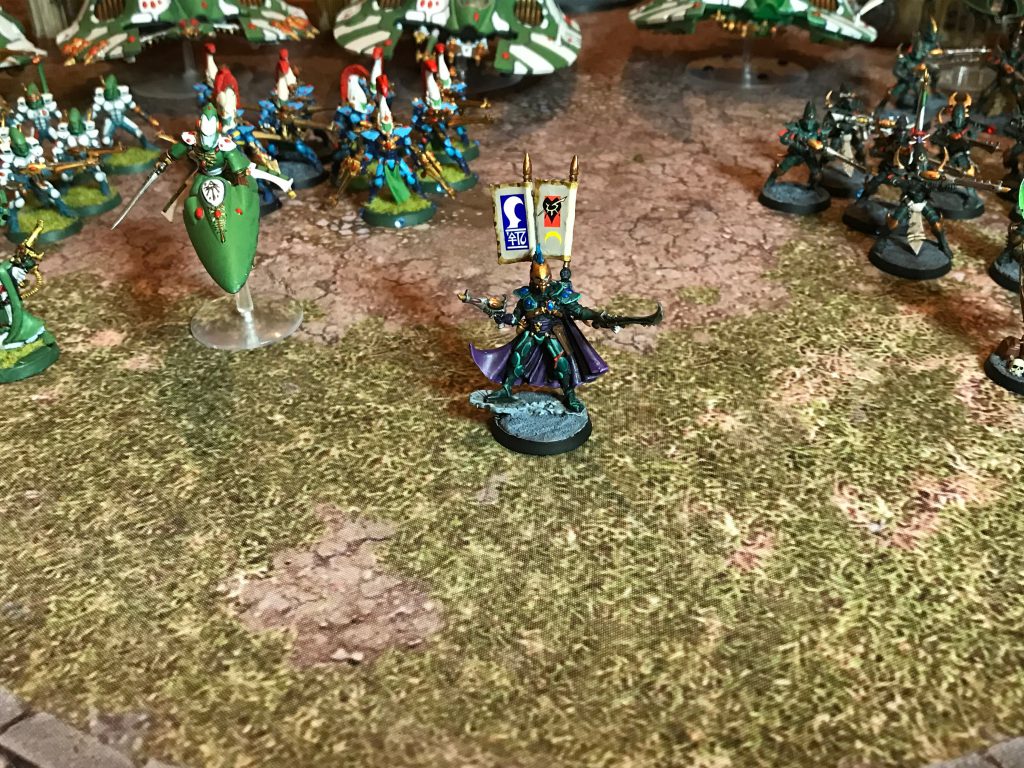
As long-time followers will know, I used to run a mixed list with a Drukhari Battalion instead of the second Craftworld one. At the Bad Moon Series, I took the following:
Army list - Click to Expand+++++++++++++++++++++++++++++++++++++++++++++++++++++++++++++++++++++++++++
+ PLAYER NAME: James Grover
+ ARMY FACTION: Aeldari
+ TOTAL COMMAND POINTS: 14
+ TOTAL ARMY POINTS: 1999pts
+ POWER LEVEL: 115
+ ARMY FACTIONS USED: Aeldari, Black Heart, Alaitoc
+ TOTAL REINFORCEMENT POINTS: 0
+++++++++++++++++++++++++++++++++++++++++++++++++++++++++++++++++++++++++++
== Battalion Detachment == Black Heart [22PL, 390pts] 5CP
HQ: Archon (70), Venom Blade (2), Splinter Pistol (0), Warlord [4PL] [72pts]
HQ: Yvraine (132) [7PL] [132pts]
TR: 5 Kabalite Warriors (30), Sybarite (0), Shredder (8) [2PL] [38pts]
TR: 5 Kabalite Warriors (30), Sybarite (0), Shredder (8) [2PL] [38pts]
TR: 5 Kabalite Warriors (30), Sybarite (0) [2PL] [30pts]
DT: Raider (65pts), Disintegrator Cannon (15) [5PL] [80pts]
== Battalion Detachment == Alaitoc [65PL, 1077pts] 5CP
HQ: Warlock Skyrunner (65), Twin Shuriken Catapult (2), Witchblade (0) [4PL] [67pts]
HQ: Farseer (110), Witchblade (0) [6PL] [110pts]
TR: 5 Dire Avengers (40), Exarch (0), 5 Avenger Shuriken catapults (15), Exarch Additional Avenger Shuriken Catapult (3) [3PL] [58pts]
TR: 5 Dire Avengers (40), Exarch (0), 5 Avenger Shuriken catapults (15), Exarch Additional Avenger Shuriken Catapult (3) [3PL] [58pts]
TR: 18 Guardian Defenders (144), 1 Guardian Heavy Weapon platform (5), 1 Scatter Laser (7) [9PL] [156pts]
EL: 5 Howling Banshees (45), Exarch (0), 4 Power Swords (16), 1 Executioner (7) [3PL] [68pts]
EL: 5 Howling Banshees (45), Exarch (0), 4 Power Swords (16), 1 Executioner (7) [3PL] [68pts]
DT: Wave Serpent (120), Twin Scatter Laser (12), Twin Shuriken Catapult (2) [9PL] [134pts]
DT: Wave Serpent (120), Twin Scatter Laser (12), Twin Shuriken Catapult (2) [9PL] [134pts]
HS: Night Spinner (110), Twin Shuriken Catapult (2) [8PL] [112pts]
HS: Night Spinner (110), Twin Shuriken Catapult (2) [8PL] [112pts]
== Air Wing Detachment == Alaitoc [28PL, 532pts] 1CP
Flyer: Hemlock Wraithfighter (200), Spirit Stones (10) [10PL] [210pts]
Flyer: Crimson Hunter Exarch (135), 2 Starcannons (26) [9PL] [161pts]
Flyer: Crimson Hunter Exarch (135), 2 Starcannons (26) [9PL] [161pts]
This did OK, finishing 3-2. In ITC, I like my current list better, but I think elements of the above have at least some things to recommend them:
- The backline Archon Warlord is actively useful, securing a backfield objective.
- The squad of five foot Kabalites is useful, rather than just being a straight liability. Even just 3×5 backline Kabalites without boats would actually just look fine here I think.
- Screaming Jets-ing a Raider full of troops onto an objective is a pretty good way to punish lists that can’t cover enough space.
- Alternatively, a Venom with a squad of Kabalites (an element of previous lists) would make an interesting back-line Engineers pick (nominating the Venom and the squad inside), as their hit mod makes a lot of indirect fire pretty poor against them. Many Guard lists use either 3×3 mortars or a double tap Wyvern as their indirect solution – neither of these picks off a Venom in a single turn on average, and my planes can eradicate them in response.
On a separate note, having briefly mattered a little less, the rise of Chaos Knights and a Taranis-focused loyalist list makes Vect more appealing again.
I wouldn’t take exactly the above – some things I’ve tried since have worked very well and I’d want to aim to keep. I’d probably be taking out at least one Night Spinner and the Banshees to include some more recent favourites, and maybe swapping the second Spinner for two Shadow Weavers and change. Altogether though, I liked quite a bit of what the above list did when I played it, and have been meaning to go back to an optimised version at some point anyway, and I think NOVA would be the ideal environment to do it.
Option 3 – Down with the Clown
Our group has long been pretty enamoured of the Harlequin murder-vanguard (Shadowseer, 2x Death Jester, Solitaire) and I think this is extremely good in the NOVA missions. Death Jesters, in particular, are hugely handy, being relatively fast character objective grabbers. This detachment also does work – the Shadowseer adds MW output, and probably takes Twilight Pathways alongside Shards of Light to give them some mobility options, one of the Death Jesters picks up Curtainfall to be extremely dangerous, and the Solitaire is a Solitaire, a living missile that will tear an unsuspecting opponent’s characters clean apart. Finally, it has an absolutely insane clutch move for the format in the “Hero’s Path” stratagem, which lets a Shadowseer, Solitaire and Death Jester within 6″ of one another all redeploy separately in any movement phase. This probably won’t come up that often, but it can theoretically do some wild stuff. The timing isn’t super easy – you activate it at the start of the phase and move at the end – but I can see this either:
- Punishing an opponent who chooses to castle in an early turn by moving some characters out onto some extra objectives.
- Giving you an emergency button to get stuff onto objectives on turn 6.
I’m not quite sure in what kind of game a Solitaire has made it to turn 6 alive and you haven’t crushed your opponent, but the option is there, and I think early-mid game shenanigans with progressive scoring are actually realistic.
The call of the webway has reached our very own Corrode, so we’ll get to find out soon enough if this actually works out.
Wrap Up
And that’s it. Wow this turned out more in depth than planned – but that’s because the NOVA missions are really interesting and the players are in for a treat. I’ll almost certainly be doing some content in September looking at lists that did well, so we’ll get to find out how I did then, but in the meantime if you want to tell me what I’ve missed, agree enthusiastically or just offer some extra insights, you can reach us at contact@goonhammer.com, or on our Facebook Page.
